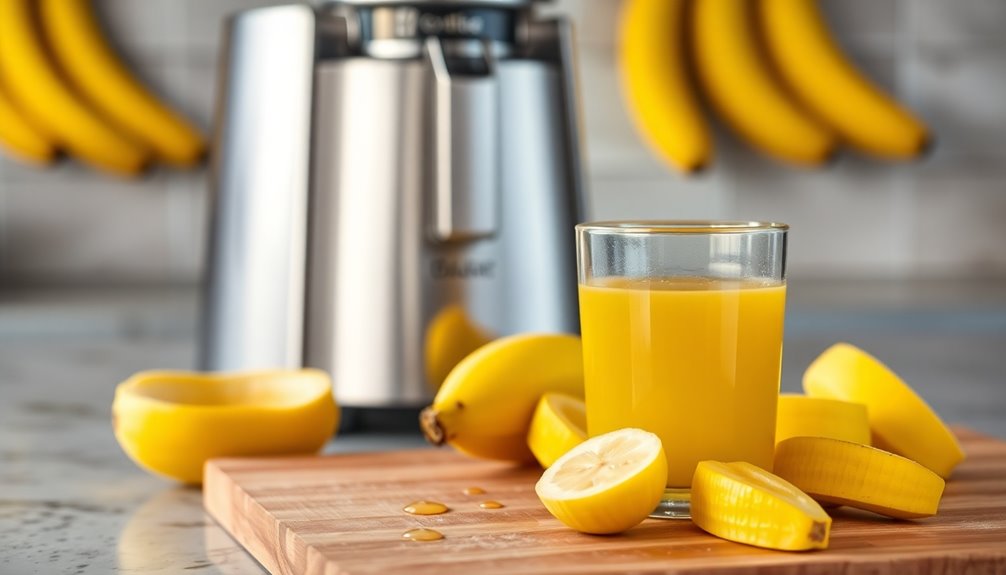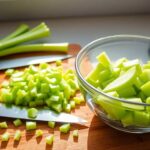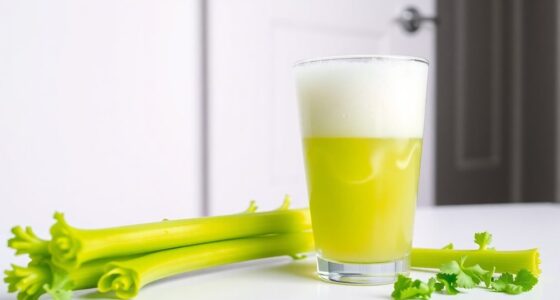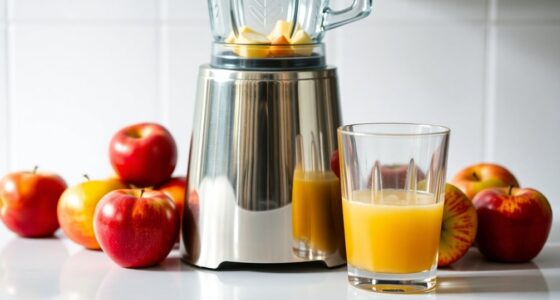To juice a banana, start with very ripe organic bananas for the best flavor. Cut them into one-inch pieces and blend with water or milk until smooth. Strain the mixture to separate the juice from the pulp. If you're looking for more depth, try an advanced method that involves heating the puree to activate enzymes for richer juice. You can also mix in other fruits like pineapple for a refreshing twist. Discover more techniques to elevate your banana juicing game!
Key Takeaways
- Start with very ripe organic bananas for the best flavor and to maximize juice yield.
- Cut bananas into one-inch pieces to facilitate better extraction in your juicer or blender.
- Blend the banana pieces with water or milk, then strain the mixture to separate liquid from pulp.
- For a richer juice, consider using the enzymatic breakdown method by heating pureed bananas at 150°F for five hours.
- Experiment by combining banana juice with other juices, like pineapple, for a delicious and nutritious drink.
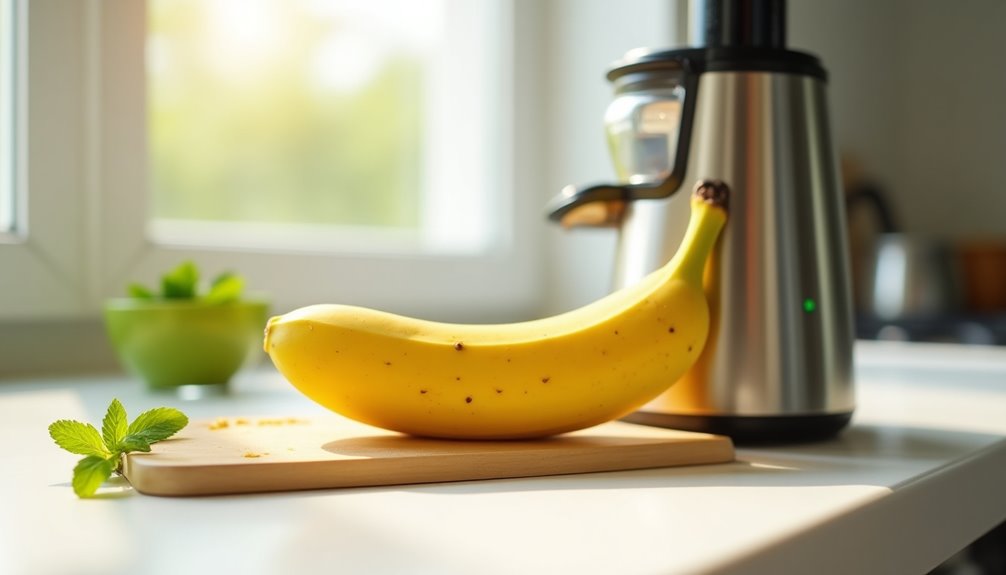
Juicing a banana may sound unconventional, but it can deliver a delicious and nutritious drink. You might be surprised to learn that ripe bananas are packed with essential vitamins, minerals, and antioxidants. To make banana juice in the best way possible, you'll want to start with very ripe bananas. They yield a sweeter, more concentrated flavor, making your fresh banana juice taste amazing.
Since bananas have a low water content, traditional juicers may struggle to extract juice effectively. Instead, using a Nama J2 juicer, which is designed for such produce, can enhance the efficiency of the juicing process.
To juice a banana effectively, cut it into one-inch pieces. This simple step helps your juicer work better and maximizes the yield. If you want to add even more health benefits to your juice, consider including banana peels. They contain higher antioxidant levels than the flesh itself. Just make sure to use organic bananas to avoid pesticides. By incorporating the peel, you'll boost the nutritional value of your drink without compromising its flavor.
Now, let's talk about how to actually juice a banana. One of the easiest methods is to blend ripe bananas with a small amount of water to make a smooth mixture. You can also use milk if you prefer a creamier texture. After blending, strain the mixture to separate the liquid from the pulp. This method is straightforward and gives you fresh banana juice without needing specialized equipment.
Keep in mind that due to the low water content in bananas, traditional juicers may not provide the best results.
If you're looking for a more advanced technique, consider the enzymatic breakdown method. This involves pureeing ripe bananas and then heating the sealed mixture at 150°F (65.5°C) for about five hours. This process activates amylase, an enzyme that helps to release juice more effectively. Although it requires a bit more time and preparation, the results can be worth it, yielding a rich and flavorful juice.
You can also experiment by mixing banana juice with other juices, like pineapple juice, to create a tropical blend that's both refreshing and nutrient-packed. The combination of flavors can elevate your drink, making it a delightful treat for any occasion.
Frequently Asked Questions
Can I Juice a Banana?
Sure, you can juice a banana! Its high water content makes it possible to extract a flavorful juice.
For best results, use very ripe bananas and cut them into one-inch pieces. When you juice, you might notice a slightly bitter taste from the peel, but it also brings antioxidants to the mix.
If you want to try something traditional, blending ripe bananas with grass is a method used in East Africa.
How Do You Get Juice Out of a Banana?
You might think getting juice out of a banana is impossible, but it's not!
Start by pureeing ripe bananas and sealing them in a vacuum bag. Heat them at 150°F for about five hours to enhance enzyme activity.
Alternatively, try microwaving the bananas for a few minutes after freezing them.
You can also blend the bananas with grass for a traditional twist, then strain for a clearer juice.
Enjoy experimenting!
How to Turn Banana Into Liquid?
To turn a banana into liquid, start by mashing or blending it with a bit of water.
You can also freeze the banana beforehand for better results.
After blending, strain the mixture through a nut milk bag or cheesecloth to separate the juice from the pulp.
If you're looking for a more efficient method, consider using a centrifuge for higher yield and quicker extraction.
Enjoy your banana liquid as a refreshing drink!
How to Make Banana Liquid?
Making banana liquid can feel like a puzzle, where blending and juicing create different outcomes.
You can start by pureeing ripe bananas, mixing them with a bit of water or other liquids for a smoother texture.
If you want a more concentrated flavor, try using a fine mesh strainer after blending.
Don't forget, you can also experiment with heating methods or juicers for varying results.
Enjoy your delicious banana liquid!
Conclusion
Juicing a banana may seem like trying to squeeze water from a rock, but with the right approach, you can unveil its hidden sweetness. Just as a painter blends colors to create a masterpiece, you combine the banana's creamy texture with other fruits to craft a vibrant elixir. Embrace the journey, and remember that sometimes, the most unexpected ingredients can lead to the most delightful discoveries. So, don't shy away from experimenting; your taste buds will thank you!
Cindy thoroughly researches juicing trends, techniques, and recipes to provide readers with practical advice and inspiration. Her writing style is accessible, engaging, and designed to make complex concepts easy to understand. Cindy’s dedication to promoting the advantages of juicing shines through her work, empowering readers to make positive changes in their lives through the simple act of juicing.

